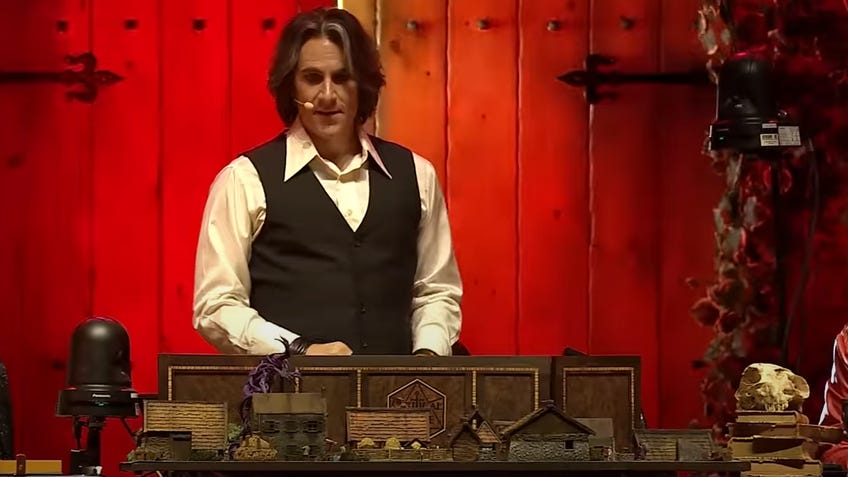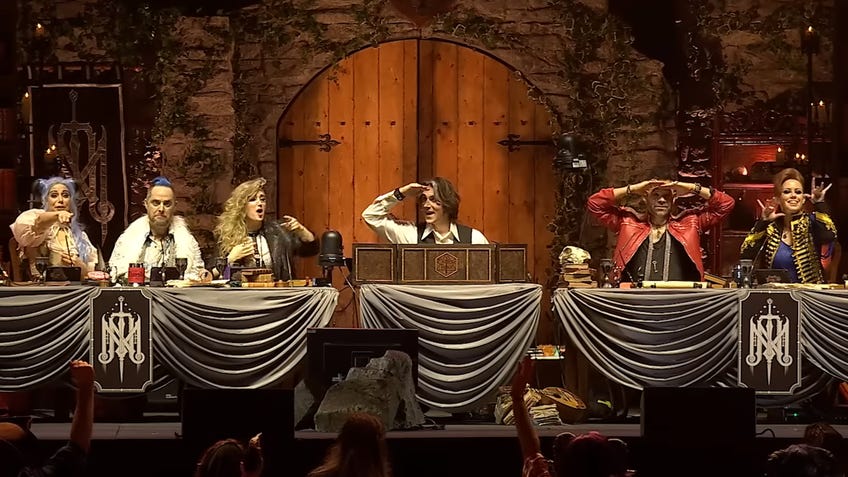Critical Role's live show nailed the rare pleasure of playing D&D at Level 20
Gods, gates and Gelidon.
When Critical Role announced an in-person London live show, reuniting The Mighty Nein from Campaign 2, it was clear this was going to be a big event – not least because it was the first time the actual play titan had done a live show anywhere in Europe.
Warning: spoilers ahead for The Mighty Nein Reunion: Echoes of the Solstice and the events of Critical Role Campaign 3.
Taking place during the events of Campaign 3, The Mighty Nein Reunion: Echoes of the Solstice saw all seven cast members reprise their Campaign 2 roles – with a single mid-episode twist, as teenage rogue/wizard Luc Brennato took the place of his far more experienced mother. Together, they pursued old foe Trent Ikithon, released from his magical shackles and intent on psychologically tormenting his old pupil once again, including resurrecting Caleb’s parents as obedient undead ghouls.
The live show did not disappoint, with a packed-out Wembley venue, a notable number of Critical Role cosplayers and roof-shaking cheers every time someone rolled a natural 20 – which was often – abetted by Scottish comedian Daniel Sloss, who both warmed up the crowd and joined the table as a surprise guest, before dying within minutes.
Playing characters at Level 20 is an achievement most D&D players can only dream of.
But the real power of this stadium episode is that the cast were finally playing their Campaign 2 characters at Level 20, marking an achievement most D&D players can only dream of.
Campaign 2 had ended just as characters hit Level 16. While we saw party members again at Level 17 for last year’s two-part Uk’otoa special, even that couldn’t compare to the thrill of watching these characters engage in Level 20 play – with the absurd power and danger that entails.

While some former editions of D&D allowed you to progress even to Level 30 and beyond, Fifth Edition is very much capped at 20, when your characters are already essentially demigods, and able to impact the battlefield and the world on a massive scale. (We expect the same from the upcoming One D&D revision, too.)
Managing challenge at Level 20 is a near-impossible balance - and one that can easily result in character death if not handled carefully.
It’s only at this tier of play you can see an archmage obliterate an entire party’s health bar with a 9th-level spell – and then see the damage instantly undone by a cleric with hundreds of hit points to deal out. You can watch a wizard duplicate himself with a Simulacrum spell, and transform into both a powerful ice dragon and a tyrannosaurus rex before charging, jointly, into the fray. By Level 20, monks can move 140 feet in a single turn, a cleric can summon their literal god to the battlefield with a Gate spell and a magically-enhanced barbarian can deal 100-plus damage on a single hit.
These clerics are so powerful they can guarantee a successful Divine Intervention from their gods and afford to waste the ability on an after-battle party. Even a skyscraper-high demon pacing through a sleeping village, disintegrating local farmers, isn’t much cause for worry when seven Level 20 adventurers all pounce upon it at once.
It’s all a long way from where most parties start at Level 1, chasing rats in a basement, or even the shows of power we saw at the start of Critical Role Campaign 2 as a low-level Jester used the cantrip Thaumaturgy to… open all the windows in a tavern. Compare that to the powers on show here and it’s clear we’re playing a very different kind of game.
There’s a good reason most tables never get to Level 20; it’s a lot more complicated for players, and harder for dungeon masters to manage, given the sheer number of abilities and the correspondingly deadly monsters that need to be thrown at the party for any real sense of challenge. It’s a near-impossible balance - and one that can easily result in character death (a bit of a downer, particularly in a live show) if not handled carefully.
Most parties also never have the privilege of playing a campaign to that high a level – given the difficulty of long-term scheduling or experienced enough players to feel comfortable playing with such high stakes. But as the saturation of the D&D media landscape continues, players will only get more comfortable with the idea of this kind of play, whether or not they’re individually likely to survive it. We can only ask for more Level 20 episodes like Echoes of the Solstice to keep showing us how it’s done.










